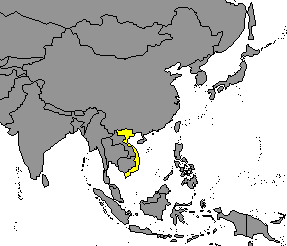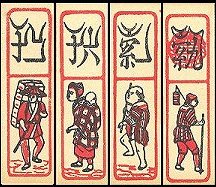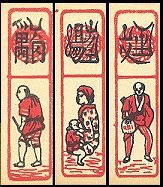 |
The pattern named Tô Tôm ("bowl of shrimps") from the main game
played is a 120-card deck. There are three traditional Chinese suits, Coins (or Cash),
Strings (or Threads) and Myriads, each of which runs from 1 to 9, plus three special cards
named Ông-Lão (or "Old Man"), Không-Thang
("Zero Strings") and Chi-Chi ("Half Coin" or "Half Cash"). Each subject
is repeated four times.
A pair of Chinese characters, referring to the suit sign and the value,
are repeated on both ends of each card; folk personages in various attitudes and
wearing traditional clothes appear in the central part, although they are merely decorative
and are not related with the rank nor with the suits. |
|
The 8s and 9s of Strings and Myriads, and the three special cards, bear a red stamp
overlapped by the two Chinese characters (see pictures in the following paragraph).
In Tô Tôm, and more generally in Vietnamese cards, the special cards
act almost as an "extension" of the ordinary suits, i.e. the "Old Man" may be added
to the nine Myriads as the tenth card of the series, while the "Half Coin" comes before
the ordinary 1 of Coins (but due to the reverse ranking of the cards in this suit,
the Half Coin is actually the highest subject).
Besides Vietnam, Tô Tôm cards are also used in GuangXi region (southern China), by the Vietnamese border.

This pattern is basically the same one as Tô Tom, but it has a fourth suit, and
only one of each subject (i.e. no duplicates). The backs are deep orange, without
any decoration.
The number of cards in the deck is 38; 35 of them belong to the four suits, and the three
remaining subjects are the "Old Man", the "Zero Strings" and the "Half Coin", as in the previous
pattern.
The suit signs and the values are identical to the ones in Tô Tom subjects, but
in this pattern they are featured only once, above the central illustration: these cards are
single-ended.
The fourth suit, Tens (in full, "tens of myriads"), matches in meaning the Sip cards of the
Hakka pattern described in the Chinese gallery page 1,
although their characters are different. Vietnamese Tens, however, do not have a 1, running
from 2 to 9. This gives reason for the total of 35 suit cards in the pack. |

2 and 6 of Tens (on the left), and
1 and 9 of Strings (on the right) |
The red stamps are featured by the same subjects as in Tô Tom cards,
i.e. the three special cards, 8 of Myriads and Strings, 9 of Tens, Myriads and Strings
(but not on the Coins one); note that Tens do not belong to
Tô Tom) cards. This scheme is not far from the one found in Hakka
cards.

8 of Coins and
5 of Myriads |
Vietnamese patterns are quite traditional, having remained unchanged for at least one century.
Originally, they were printed in France by A.Camoin & C ie, a
manufacturer in Marseille who produced a whole range of "exotic" playing card patterns for
overseas territories, among which were also Chinese chess and Domino decks (see Chinese
gallery page 2 and page 3). The cards
were then exported to South-eastern Asia, especially to the French colonies Tonkin
(presently, northern Vietnam) and Cochinchina (southern Vietnam). |

"Old Man", "Zero Strings"
and "Half Coin" |
OTHER CHINESE PATTERNS USED IN SOUTH-EASTERN ASIA
In South-eastern Asia the long variety of the four colour chess cards is
identical in composition and shape to the ones manufactured in China (see
Chinese gallery,
page 2).
The Vietnamese name for the four colour cards is
Bai Tu Sac.
Also two colour chess cards, i.e. with the black side vs. the red or white side, are produced both in Thailand and in Vietnam. The Thai edithion is faithful to the Chinese
standard, featuring a rather essential graphic style, printed in black and red. Instead, the
Vietnamese editions are more ornate and colourful, with figurines of the subjects in the
center of the card.
Lastly,
Mah Jong decks are sometimes found in Vietnam and in Malaysia. A full
description with pictures is given in the Chinese gallery,
page 1.
Vietnamese decks are long and thin, as most ones manufactured in China or Hong Kong, while
editions made in Malaysia tend to be the large sized variety.